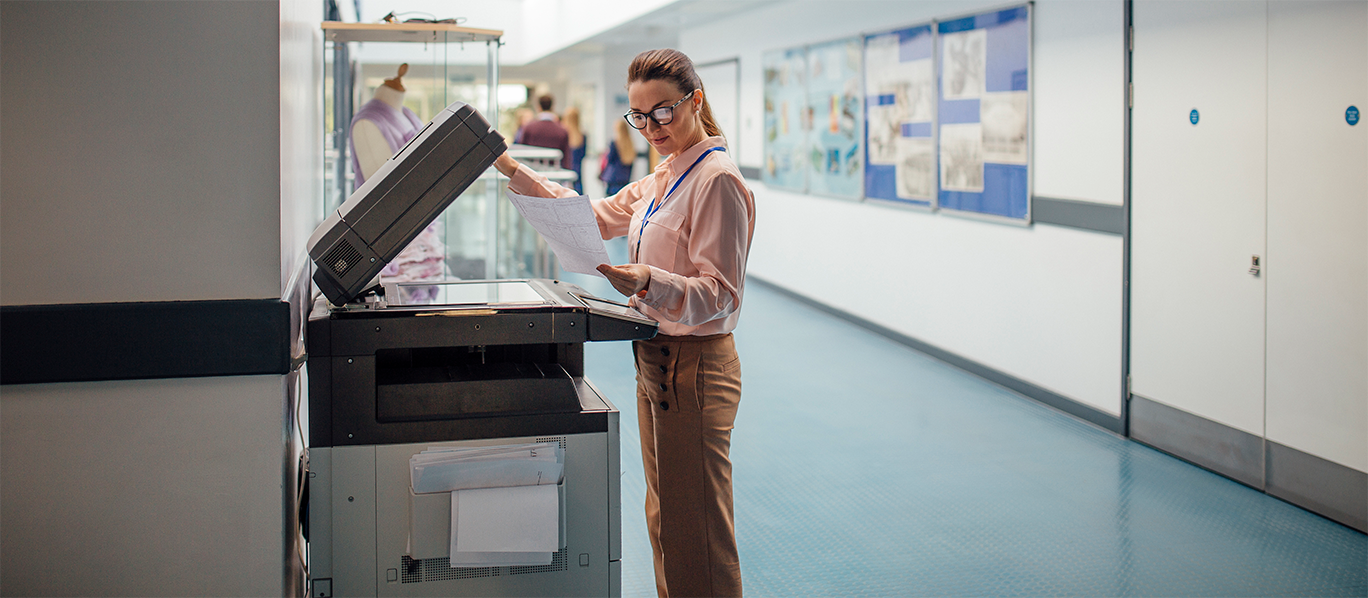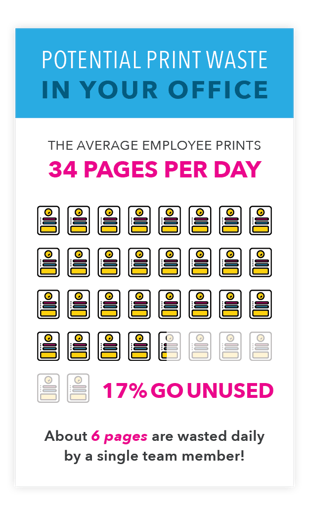Updated: July 29, 2021
3 Ways To Reduce Printing Costs

If you have access to a printer, there’s a high probability that you print without restrictions – and so do your employees. Each person decides how many prints they want to make, if they’re in black and white or color, or if they even need to print the document at all.
For many office managers, an office-wide print policy may not inherently take top priority. You may assume your employees will make the right judgment call when using company resources – like the paper and ink it takes to complete a laundry list of print jobs.
However, even if your employees always print responsibly, you're likely incurring hidden print costs or spending more than you should on certain parts of your print operations. But you're not alone. 90% of companies don’t know how many printers they have or how much they spend on printing.
In this post, we'll highlight three printing operations that could be costing you big bucks behind the scenes and a few easy ways to reduce printing costs.
Keep an eye on daily volume.
On average, one employee prints 34 pages per day. Now multiply that by every team member, in every department, in every office location. Crazy, right? What's even crazier is how many of these documents get stashed away for an indefinite later time, or worse, wasted altogether – 17% of these 34 pages are never used for their intended purpose.
No matter where they originate, unnecessary prints can impact your bottom line and increase your carbon footprint over time.
The best way to get ahead of excessive printing is to implement an office print policy. You can stay away from micro-managing every sheet of paper your employees use, but setting clear guidelines in place to minimize waste and encourage teams to go digital wherever possible can significantly reduce printing costs.
First, use a monitoring system to determine who prints what type of documents, which printers they use (desktop or copier), and how many pages they print on average. With your results in hand, you'll be able to identify some "quick wins" that could streamline printing and cut down on waste. Consider questions like:
- Are employees using the right printer for the right job? Printing an internal memo on a high-caliber printer meant for marketing materials means greater costs and less efficiency.
- How often are documents thrown out due to printer errors? Unreliable printers can leave you with spotty ink, bleed-outs, and print job errors that make documents unusable.
- When do we use color vs. black-and-white or single vs. double-sided prints? A printer that defaults to color ink or single-sided prints may be the cause of inflated costs.
An office print policy shouldn't focus solely on limiting the number of pages with strict rules or a tedious paper monitoring process. It should be about optimizing your entire printing workflow and giving staff usage guidelines for essential pieces of office hardware.
Don't default to color prints.
Speaking of default settings, a good number of popular printer brands automatically default to color ink. While color prints are necessary for certain assets, like marketing brochures and flyers, your teams shouldn't be printing every single document with color ink.
Color is typically the greatest culprit of high printing expenses. Cost-per-page for color print can be 8X or more higher than black and white prints depending again on the type of printer you use.
For example, smaller color printers tend to be VERY expensive to operate. Often the price of consumables for smaller desktop printers is exponentially higher than the cost to buy the printer hardware itself.
Unnecessarily printing in color, when black and white will do, can definitely cost you. And ensuring you don't overdo it on color requires a mix of clear internal print guidelines, employee education, and the proper hardware.
Be sure employees know to check the print job settings before hitting the big green button, and add guidelines around color prints to your printing policy. Then, back up your efforts by ensuring your printers are the right fit for your office. They should be effective yet easy to operate and integrate with your computer systems and document management software.
Reduce, reuse, recycle – and reoptimize.
As you improve your printing habits and potentially optimize your printing systems, keep track of the resources you use to keep your office running each day. Expenses for paper and ink cartridges often feel like a necessary evil, but a bit of care can help you reduce printing costs and keep your carbon footprint down.
Instead of placing used toner cartridges in the trash when they're empty, encourage employees to recycle them – this is also a great habit to adopt for your paper goods. You may even be able to partner with a recycling program or redemption center to trade your empty cartridges for a small rebate or savings on future purchases.
Beyond disposing of print materials properly, you'll want to be sure you're purchasing and using the right products in the first place. Perhaps you're splurging a bit too much on top-tier printer paper for simple internal jobs, or you're ordering supplies on a whim without checking your inventory or recent usage habits.
Additionally, if you bought into a dealer printing contract, you may simply have too many printers or a system that requires expensive cartridges and continuous updates to stay afloat.
A business technology partner can assess your existing operations to ensure you have the correct number of printers. They'll also ensure equipment in your office is equal parts effective and cost-efficient.
-
Are your current print processes incurring hidden expenses or slowing down internal teams?
Maybe now is the time to evaluate and rethink your print strategy moving forward. With newer print tracking technology, it’s now easier than ever to assess, identify, and calculate quick hit business opportunities.
At UBEO, we believe workflow optimization comes from the combined power of your people, processes, and technology – and your printing operation is just one aspect of your business that could benefit from a unified management system.
We evaluate your current business practices, then introduce high-value solutions designed to optimize processes and give your department the resources it needs to be successful.
Contact our team today to see how we can support your print operations.


